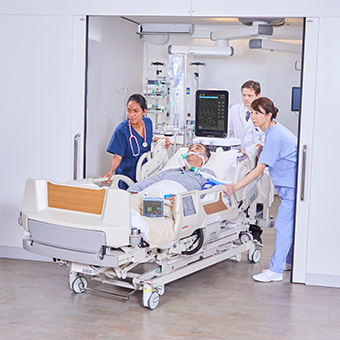By: Patrick H Knight, Neelabh Maheshwari, Jafar Hussain, Michael Scholl, Michael Hughes, Thomas J Papadimos, Weidun Alan Guo, James Cipolla, Stanislaw P Stawicki, and Nicholas Latchana
Published: National Center for Biotechnology Information, U.S. National Library of Medicine
Date: December 5, 2017
Airway-related and pulmonary complications can occur during IHT, especially in the intensive care unit (ICU), trauma, and perioperative settings where a relatively high proportion of patients require mechanical ventilation thereby leading to an added complexity of the transport process. Symptomatic pneumothorax and atelectasis occur at an increased frequency in patients undergoing IHT.[1] In fact, the risk of pneumothorax may be elevated more than 2-fold while the occurrence of atelectasis may be increased nearly 3-fold in patients undergoing IHT.[1,22,23] Furthermore, there may be increased risk of developing deep vein thrombosis in transported patients (odds ratio of 4.5), which may subsequently lead to increased incidence of pulmonary embolism.[1]
Airway displacement risk may also be significant, yet it often is an under-recognized problem. Extrapolating from out-of-hospital transfers involving 77 pediatric and neonatal intubated patients, post-intubation chest roentgenograms demonstrated that the endotracheal tube was malpositioned in nearly half of the cases.[24] Although risk of similar occurrences during IHT may be lower, it is likely not negligible, and patient movement/transportation is likely to cause airway positioning challenges. Parmentier-Decruq et al.[5] examined a cohort of 262 mechanically ventilated patients who underwent IHT. Of all adverse events, 0.4% included accidental extubation, 8.8% involved oxygen desaturation, and 17.6% were incidents involving airway-related equipment.[5] Of note, risk factors for oxygen desaturation included positive end-expiratory pressure (PEEP) of >6 cmH2O as well as the use of treatment modification(s) for transport. In the aforementioned study, the largest sub-group of adverse events were equipment related incidents, including improper alarm settings and battery issues related to airway monitoring devices.[5] Of note, the presence of anesthesia trainees during patient transport activities was associated with fewer equipment related events, likely due to better familiarity with equipment and the ability to anticipate potential problems. In another report, Venkategowda et al.[25] examined a cohort of 254 ICU patients and again demonstrated that the majority of unexpected events during IHT were related to equipment malfunction. Unexpected events occurred in 139 patients, and 64% of adverse events were related to equipment issues such as oxygen probe displacement.[25] Furthermore, oxygen desaturation accounted for 10.8% of recorded adverse events.
In a study by Papson et al.[26] intrahospital transports involving 297 critically ill patients were characterized by as many as 640 unexpected events (e.g., 2.15 events per patient). Thirty events were considered significant, including 4 necessitating securing of the airway. Oxygen desaturation comprised 2.3% of unexpected events while equipment related events (probe disconnection, ventilator circuit leaks and ventilator failure) accounted for 11.3%. Furthermore, accidental extubation has been estimated to occur in nearly 1% of transports involving 1,659 ventilated patients in another study.[1] Although a rarity, attention should be given to accidental extubation as the risk of rapid patient demise without prompt intervention is inherent. Targeted prevention measures and experienced staff capable of providing ventilation and performing emergent airway intubation are invaluable during transport to prevent airway loss and reducing delays in reestablishing a definitive airway.
Outcomes with manual ventilation have also been compared to mechanical ventilation. One prospective study[27] examined transfers of 36 ventilator-dependent patients, of whom 20 received manual ventilation with a ventilatory bag while 16 patients were transported using portable mechanical ventilators. Fourteen out of the 20 manually ventilated patients experienced changes in parameters on arterial blood gas analysis (e.g., changes in pCO2 > 10 mmHg or changes in pH >0.05). There were significantly fewer alterations in the group that received mechanical ventilation compared to manual ventilation (P < 0.01).[27]
In summary, pulmonary complications associated with IHT are often attributed to equipment related issues and may be increased with manual ventilation relative to mechanical ventilation. This understanding should form the framework for the development of systematic solutions to circumvent and/or prevent such problems. Furthermore, experienced team members accompanying the transported patient can (and should) facilitate prevention, early recognition and definitive treatment of potential respiratory/pulmonary complications that may occur during IHT.
Source: https://www.ncbi.nlm.nih.gov/pmc/articles/PMC4705572/
Image: https://orange-med.com/wp-content/uploads/2019/08/application_intra_hospital_340x340.jpg
Analysis:
The purpose of this article identifies airway and pulmonary complications a patient will endure when experiencing an intrahospital transport while connected to a mechanical ventilator. As outlined early in the article, this particular problem is one that can be easily overlooked, yet the risk effects are quite significant. A causation for airway challenges such as accidental extubation, oxygen desaturation (PEEP), oxygen probe displacement or other airway accidents result from malfunctioned airway-related equipment due to movement/transportation. Additional obstacles that occur during transportation include improper alarm settings and battery issues that operate and monitor airway devices. Overall, pulmonary (lung) complications result from the ventilators and other associated equipment that accompany a patient when being transported for one location to another, within a hospital. With varying issues extending from equipment malfunctions to bedside team members unable to predict accidents, all culminate to the risk and recovery of the patient.




